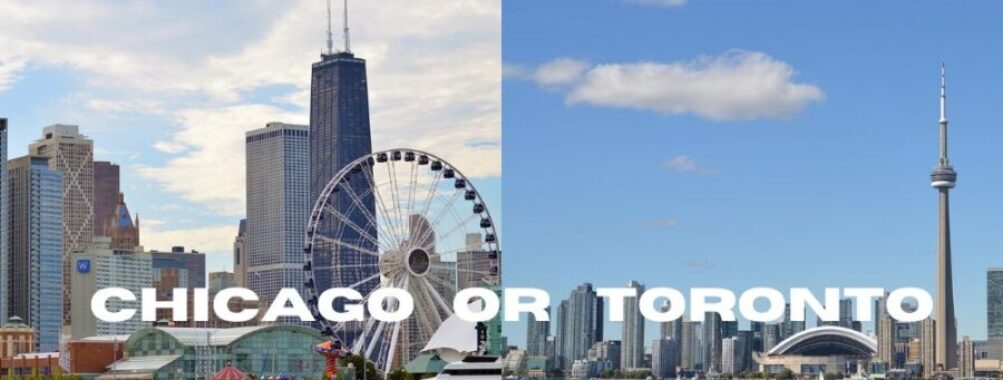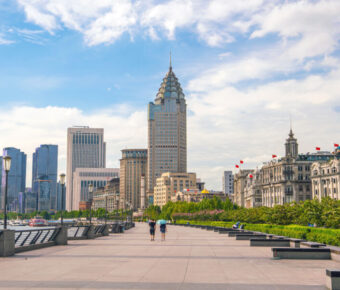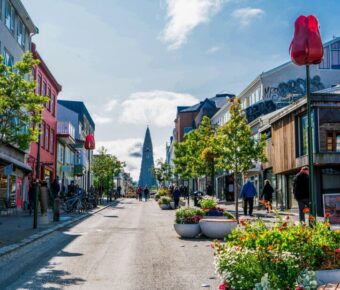
Chicago vs Toronto: Battle of North America’s Most Dynamic Cities Revealed
Two towering metropolises of North America, Chicago and Toronto, both claim their spot as cultural powerhouses. These cosmopolitan cities draw millions of visitors each year with their unique blend of art, food, and urban energy. While Chicago offers more sunshine and lower living costs, Toronto stands out as the safer choice with a crime index of 58.44 compared to Chicago’s 33.85.
The rivalry between these multicultural giants extends beyond just tourism. Each city brings its own flavor to the table – Toronto with its diverse neighborhoods and winning basketball culture, Chicago with its deep-dish pizza and legendary blues scene. Their skylines compete for attention, their food scenes spark endless debates, and their cultural offerings keep tourists coming back for more.
Both cities sit on the shores of vast bodies of water, shaping their identity and climate. Life moves at different speeds in each place, with distinct personalities that reflect their respective countries. Get ready to explore what makes each of these urban giants tick, and maybe pick your next travel destination along the way.
Table of Contents
- Geographical Location and Climate
- Chicago’s Lakefront and Climate
- Toronto’s Waterfront and Weather Patterns
- Population and Demographics
- Chicago’s Diverse Communities
- Toronto’s Cultural Mosaic
- Economy and Employment
- Chicago’s Economic Landscape
- Toronto’s Financial Health
- Educational Institutions
- Universities in Chicago
- Toronto’s Academic Excellence
- Cost of Living and Housing
- Cost of Living in Chicago
- Toronto’s Living Expenses
- Transportation Systems
- Navigating Chicago
- Getting Around Toronto
- Landmarks and Attractions
- Iconic Sites in Chicago
- Toronto’s Top Destinations
- Cultural Experiences and Cuisine
- Chicago’s Food Scene
- Toronto’s Culinary Delights
- Entertainment and Nightlife
- Chicago’s Vibrant Nightlife
- Toronto’s Entertainment Hubs
- Frequently Asked Questions
- What are the similarities and differences between the skylines of Chicago and Toronto?
- How does the cost of living in Chicago compare to that of Toronto for potential movers?
- For a hockey fan, how do the Chicago Blackhawks and Toronto Maple Leafs match up historically?
- Which city generally experiences harsher winters, Chicago or Toronto?
- In terms of tourist attractions and activities, how do Chicago and Toronto contrast for visitors?
- Discuss the different cultural experiences one might expect when choosing between a visit to Chicago or Toronto?
- Book Your Dream Experience
- More Travel Guides
Geographical Location and Climate
Both cities sit on the shores of Great Lakes, shaping their weather patterns and urban development. Each has distinct seasonal changes and waterfront characteristics that affect daily life.
Chicago’s Lakefront and Climate

Lake Michigan creates a striking backdrop for Chicago’s skyline and influences its weather year-round. The lake effect brings extra snow in winter, with temperatures often dropping below freezing from December through February.
Summer days can reach 85°F with high humidity. The city gets about 36 inches of rain yearly. Spring brings unpredictable weather with quick shifts between warm and cold days.
The 26-mile lakefront features beaches, parks, and walking paths. Strong winds earned Chicago its “Windy City” nickname, though more from politics than weather. Lake Michigan moderates temperatures, making waterfront areas slightly cooler in summer and warmer in winter.
Toronto’s Waterfront and Weather Patterns

Toronto sits on Lake Ontario’s northwestern shore, about 440 miles northeast of Chicago. The city experiences four distinct seasons with more moderate temperatures than Chicago thanks to lake effects.
Winter temperatures typically range from 20°F to 35°F. The city gets around 45 inches of snow yearly, less than Chicago. Lake Ontario rarely freezes, helping keep winter temperatures milder than inland areas.
Summer brings pleasant temperatures between 70°F and 80°F. Toronto’s 28-mile waterfront hosts parks, marinas, and islands perfect for summer activities. The lake creates cooling breezes that make hot days more comfortable.
Spring arrives later than in Chicago, while fall tends to be crisp and colorful. Lake Ontario’s thermal mass helps extend mild temperatures into autumn.
Population and Demographics
Both cities show striking differences in population size and cultural makeup. Toronto leads with about 6.4 million people in its metro area, while Chicago has roughly 2.7 million residents.
Chicago’s Diverse Communities

Chicago’s population includes a rich mix of ethnic groups. African Americans make up about 29% of residents, while Hispanic communities represent 28% of the city. The city’s North Side features vibrant Polish and Irish neighborhoods.
Many ethnic groups have left their mark on Chicago’s identity. You’ll find authentic food markets in Little Italy and colorful murals in Pilsen’s Mexican American district. Asian Americans, making up 7% of residents, have created bustling communities like Chinatown.
Toronto’s Cultural Mosaic

Toronto stands as one of the most multicultural cities globally, with nearly 50% of residents born outside Canada. The city welcomes about 100,000 new immigrants yearly, adding to its diverse fabric.
Little Portugal, Little Italy, and multiple Chinatowns showcase the city’s cultural richness. Each neighborhood brings unique festivals, foods, and traditions to Toronto’s identity.
The city speaks over 140 languages, and you’ll hear many of them just walking down the streets. Different cultural groups live and work together, creating fusion restaurants, mixed cultural events, and blended art scenes.
Economy and Employment
Toronto and Chicago stand as economic powerhouses in their respective countries, with distinct job markets and financial strengths. Each city offers unique career opportunities across different sectors.
Chicago’s Economic Landscape

Chicago’s economy produces around $450 billion in GDP, making it one of North America’s largest economic centers. The city thrives on its diverse business sectors and strong corporate presence.
The financial district houses major banks and trading firms, creating thousands of high-paying jobs. Tech companies keep growing in the city, with many startups choosing Chicago as their base.
Manufacturing remains important to Chicago’s economy, though it’s smaller than in past decades. The city has adapted by growing its service and tech sectors.
Toronto’s Financial Health

Toronto’s economy keeps getting stronger, especially in tech and finance. The city attracts global talent and serves as Canada’s main business hub.
The job market stays competitive, with many companies offering good salaries. Toronto’s tech scene has grown fast, bringing new jobs and innovation to the city.
Banks and financial firms make up a big part of Toronto’s economy. The city ranks among North America’s top financial centers, right behind New York.
Local startups find good support through business programs and funding options. This helps create more jobs and keeps the economy moving forward.
Educational Institutions
Toronto and Chicago each offer world-class education through their extensive networks of prestigious universities and colleges. Both cities have made huge investments in higher education, creating vibrant academic communities that attract students from around the globe.
Universities in Chicago

The University of Chicago stands as one of America’s most respected institutions. Its Gothic architecture and Nobel Prize-winning faculty create an atmosphere of academic excellence. The school ranks among the top 10 universities worldwide.
The city also houses several other notable schools. DePaul University operates as the largest Catholic university in the US. Loyola University Chicago offers strong programs in medicine and law.
Students can choose from specialized institutions too. The School of the Art Institute of Chicago trains future artists and designers. Illinois Institute of Technology focuses on engineering and architecture.
Toronto’s Academic Excellence

The University of Toronto leads Canada’s academic landscape with three distinct campuses across the city. Its St. George campus sits in the heart of downtown, while Scarborough and Mississauga locations serve the greater metro area.
York University stands out for its innovative programs in fine arts and business. Ryerson University specializes in career-focused education with strong ties to industry.
Toronto’s schools welcome a diverse student population. International students make up over 20% of enrollment at major universities. This creates a rich mix of cultures and perspectives in classrooms.
Programs range from traditional liberal arts to cutting-edge research in artificial intelligence and biotechnology. Many schools offer co-op programs that combine classroom learning with paid work experience.
Cost of Living and Housing
Living costs vary between Chicago and Toronto, with Chicago being about 4% more expensive. Housing prices show notable differences, with Toronto offering more affordable options for both renters and buyers.
Cost of Living in Chicago

Chicago’s monthly living expenses run higher than Toronto’s, with residents needing around $4,973 after taxes to maintain a comfortable lifestyle. The city’s housing market reflects these higher costs. Rent prices for a one-bedroom apartment in prime areas often exceed $2,000 per month.
Groceries and daily essentials cost more in Chicago too. Basic utilities like electricity, heating, and water add up to higher monthly bills compared to Toronto.
The good news? Chicago offers higher average salaries to help offset these costs. A typical salary covers about 1.8 months of expenses.
Toronto’s Living Expenses

Toronto’s cost of living sits about 10% below Chicago’s rates. The average person needs roughly $3,120 monthly after taxes to live well here. Housing costs run about 14% lower than Chicago, making it easier to find affordable homes and apartments.
Daily expenses like food and clothing come in cheaper too. Toronto’s grocery prices beat Chicago’s by a noticeable margin.
The trade-off comes with salaries – Toronto jobs typically pay less than similar roles in Chicago. Monthly earnings typically cover about 1.4 months of expenses.
Remember to factor in healthcare differences – Toronto’s public system can mean big savings compared to U.S. medical costs.
Transportation Systems
Both Chicago and Toronto offer extensive public transit networks that make getting around easy for residents and tourists. Each city has unique features that set their systems apart.

The Chicago Transit Authority (CTA) runs the city’s famous “L” trains – the elevated rail system that’s become a symbol of the city. The L network has 8 color-coded lines that connect downtown with neighborhoods in all directions.
Buses fill in the gaps between train lines. The CTA operates over 120 bus routes throughout Chicago’s neighborhoods. Most run frequently during peak hours.
Getting around by bike is getting easier too. Chicago has added 200+ miles of bike lanes and paths in recent years. The Divvy bike-share system lets you grab a bike from 600+ stations across the city.
Getting Around Toronto

Toronto’s transit system stands out for its extensive subway coverage. The TTC (Toronto Transit Commission) runs 4 subway lines that reach far into the suburbs. The iconic streetcars are another Toronto transit signature – these rail vehicles run on dedicated lanes through downtown.
The bus network covers areas not served by rail. Over 140 bus routes connect to subway stations and run through neighborhoods across Toronto.
Cyclists enjoy 600+ km of bike lanes and trails in Toronto. The Bike Share Toronto program provides thousands of bikes at hundreds of stations for short trips around the city.
Landmarks and Attractions
Both cities showcase stunning architecture and world-famous attractions that draw millions of visitors each year. Each destination offers unique skylines and cultural landmarks that tell fascinating stories about their history and development.
Iconic Sites in Chicago

The Willis Tower stands as a symbol of Chicago’s impressive skyline. At 1,451 feet tall, this architectural giant offers breathtaking views from its glass-floor Skydeck.
Millennium Park dazzles visitors with its unique mix of art and green space. The famous Cloud Gate sculpture (nicknamed “The Bean”) reflects the city’s skyline and creates perfect photo opportunities.
The Art Institute of Chicago ranks among the world’s best book museum tickets and tours ahead of time. Its collection includes famous works like American Gothic and Nighthawks.
Toronto’s Top Destinations

The CN Tower defines Toronto’s skyline. This 1,815-foot communications tower lets guests walk on glass floors and dine in a rotating restaurant with spectacular city views.
Casa Loma brings medieval charm to modern Toronto. This Gothic Revival castle features secret passages, decorated suites, and beautiful gardens that transport visitors to another era.
The Royal Ontario Museum houses amazing natural history and world culture exhibits. Its crystal-shaped architecture makes it stand out as one of Toronto’s most recognizable buildings.
St. Lawrence Market offers food lovers a taste of Toronto’s best local flavors. The historic building dates back to 1803 and now hosts over 120 vendors selling fresh foods and unique crafts.
Cultural Experiences and Cuisine
Both Chicago and Toronto shine with unique food scenes that reflect their diverse populations and cultural heritage. Each city brings distinct flavors and dining experiences that make them standout destinations for food lovers.
Chicago’s Food Scene

Deep-dish pizza rules Chicago’s food landscape. Lou Malnati’s and Giordano’s serve up these famous thick-crust pies loaded with chunky tomato sauce and melted cheese.
The city’s food goes way beyond pizza though. Maxwell Street’s Polish sausages and Chicago-style hot dogs topped with pickles, tomatoes, and that signature neon-green relish are must-try street foods.
Little Italy and Greektown offer authentic ethnic eats. You’ll find homemade pasta, fresh gyros, and family-run bakeries that have operated for generations.
Trendy neighborhoods like West Loop feature award-winning restaurants from creative chefs who blend global influences with Midwestern ingredients.
Toronto’s Culinary Delights

St. Lawrence Market is Toronto’s food paradise. The historic market hall houses vendors selling peameal bacon sandwiches – a Toronto invention featuring Canadian bacon on a soft bun.
The city’s multiculturalism shines through its varied neighborhoods. Kensington Market blends Jewish delis, Vietnamese pho shops, and Latin American street food all within a few blocks.
Little Italy, Chinatown, and Greektown showcase authentic cooking from immigrant communities. Family recipes passed down through generations create truly memorable meals.
Food halls like Assembly Chef’s Hall bring together diverse cuisines under one roof. Local chefs serve up everything from sushi to Caribbean jerk chicken to Polish pierogi.
Entertainment and Nightlife
Both cities offer incredible entertainment scenes with distinct vibes. Chicago shines with its legendary blues bars and comedy clubs, while Toronto stands out with its film festivals and diverse cultural events.
Chicago’s Vibrant Nightlife

Chicago’s music scene is second to none. The city boasts world-famous blues clubs in neighborhoods like River North and Lincoln Park. Live jazz fills the air at the Green Mill, a historic spot that’s been rocking since 1907.
The comedy scene here is legendary. Second City has launched countless careers, including Bill Murray and Tina Fey. Shows run nearly every night of the week.
The city comes alive after dark with nightclubs along Rush Street and River North. Smart Bar draws dance music fans, while Beauty Bar mixes haircuts with cocktails for a unique night out.
Toronto’s Entertainment Hubs

Toronto’s King Street West buzzes with energy. The area hosts the famous Toronto International Film Festival, turning the city into a star-studded celebration each September.
The theater district rivals London and New York. The Royal Alexandra Theatre showcases Broadway hits, while smaller venues like Factory Theatre spotlight Canadian talent.
Entertainment District clubs keep the party going until 2 AM. The Drake Hotel combines art, music, and dining into one cool package. Nearby, Lee’s Palace hosts indie rock shows in a historic building covered in wild murals.
The Rogers Centre and Scotiabank Arena bring major concerts and sports events to the heart of downtown. These venues draw top performers year-round.
Frequently Asked Questions
Chicago and Toronto are two major North American cities with distinct qualities in their skylines, attractions, sports teams, and cultural experiences that shape daily life for residents and visitors alike.
What are the similarities and differences between the skylines of Chicago and Toronto?
Chicago boasts 126 skyscrapers with its famous architectural heritage dating back to the late 1800s. The city pioneered many modern building techniques and hosts iconic structures like Willis Tower and John Hancock Center.
Toronto’s skyline features the CN Tower as its centerpiece, surrounded by sleek glass towers built mostly in recent decades. The city continues to grow vertically with new construction projects.
How does the cost of living in Chicago compare to that of Toronto for potential movers?
Toronto ranks among North America’s most expensive cities, with high housing costs in both rental and purchase markets. The Canadian healthcare system reduces medical expenses for residents.
Chicago offers more affordable housing options in many neighborhoods. Food, transportation, and entertainment costs tend to be lower than Toronto, though healthcare expenses can be significant.
For a hockey fan, how do the Chicago Blackhawks and Toronto Maple Leafs match up historically?
The Toronto Maple Leafs claim 13 Stanley Cup championships, with most wins coming during the Original Six era. The team maintains one of hockey’s most dedicated fan bases.
The Chicago Blackhawks have won 6 Stanley Cups, with three coming in recent years (2010, 2013, 2015). Both teams share intense rivalries and passionate supporters.
Which city generally experiences harsher winters, Chicago or Toronto?
Chicago’s winters feature the famous wind chill effect from Lake Michigan, making temperatures feel much colder than recorded. The “Windy City” nickname comes from these bitter winter conditions.
Toronto experiences slightly milder temperatures but more snowfall on average. Lake Ontario helps moderate extreme temperature swings.
In terms of tourist attractions and activities, how do Chicago and Toronto contrast for visitors?
Chicago draws visitors to Millennium Park, Navy Pier, and the Art Institute. The city’s deep-dish pizza and blues clubs create unique cultural experiences.
Toronto offers diverse attractions like the CN Tower, Royal Ontario Museum, and St. Lawrence Market. The city’s multicultural neighborhoods provide varied dining and shopping options.
Discuss the different cultural experiences one might expect when choosing between a visit to Chicago or Toronto?
Chicago reflects American urban culture with its jazz heritage, sports traditions, and distinct neighborhoods. The city’s food scene goes beyond pizza to include diverse ethnic cuisines.
Toronto stands as one of the world’s most multicultural cities. Visitors can experience Little Italy, Chinatown, Little Jamaica, and many other cultural enclaves all within city limits.



